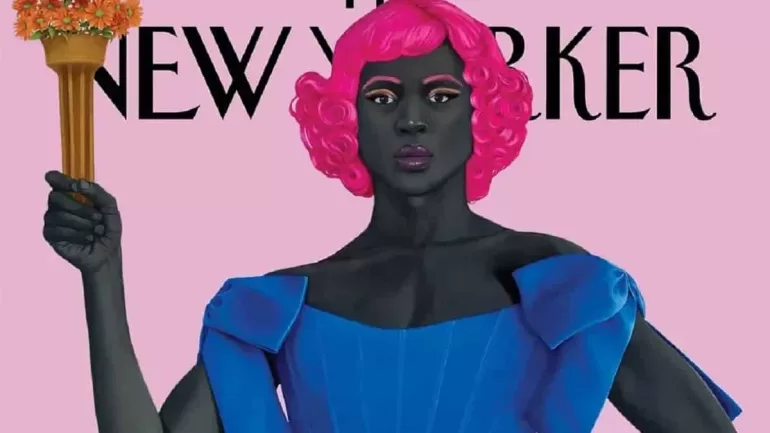ART NEWS
Featured on The New Yorker cover, Amy Sherald Trans Forming Liberty brings race, gender, and symbolism to the forefront of public discourse.
BY ARTCENTRON ART NEWS
NEW YORK, NY– The New Yorker has propelled Amy Sherald’s Trans Forming Liberty (2024) into the national spotlight by placing the portrait on the cover of its June issue. Known for its cultural authority, the magazine has introduced Sherald’s latest work to a wider audience. The audience includes many who were previously unaware of the painting, its powerful message, and the controversy surrounding it.
While art lovers have followed Sherald’s work for years, the visibility from The New Yorker places Trans Forming Liberty at the center of a much broader public conversation. That conversation includes heated debate over the painting’s canceled showing at the Smithsonian’s National Portrait Gallery and its connection to a Trump-era executive order targeting so-called “anti-American ideology” in federally funded institutions.
Amy Sherald Trans Forming Liberty for Inclusion
At the heart of the story is Sherald’s bold and unflinching portrait. Trans Forming Liberty features Arewà Basit, a Black transgender model and performance artist, reimagined as a modern Statue of Liberty. With this work, Sherald challenges dominant narratives about identity, symbolism, and who gets to embody the values America claims to represent.
The painting is more than a statement—it’s a confrontation. It asks, “Who is seen as the face of freedom?” And who remains invisible in our national symbols?
Now on view at the Whitney Museum of American Art, Trans Forming Liberty is a featured highlight of Sherald’s critically acclaimed traveling exhibition, American Sublime. The exhibition remains open through August 10, 2025.
Controversy at the Smithsonian: Censorship or Context?
The exhibition was originally scheduled to appear at the Smithsonian’s National Portrait Gallery in Washington, D.C., this fall. But that plan changed when Sherald withdrew the show in protest.
According to Sherald, Smithsonian officials proposed removing the portrait from the physical exhibition and replacing it with a video piece that featured public reactions—including anti-trans viewpoints. Sherald denounced this proposal as a form of institutional censorship, arguing that it diluted and undermined the intent of her work.
Her decision sparked widespread debate over artistic freedom, curatorial responsibility, and the role museums play in shaping public discourse. Was the Smithsonian attempting to offer “balance,” or were they giving space to harmful ideologies under the guise of context?
Political Reactions and Cultural Tensions
In response to Sherald’s withdrawal, the Smithsonian Institution released a statement denying any intent to censor. They claimed their goal was to “contextualize” the work rather than remove it.
But the controversy escalated. A spokesperson from the Trump administration publicly supported the museum’s approach, framing it as a “principled and necessary step” to uphold “traditional American values.”
This political support revealed deeper tensions. Sherald’s work had become entangled in a larger cultural battle over what stories American institutions are allowed—or pressured—to tell. The Smithsonian continues to face scrutiny under a lingering executive order that accuses federally funded arts programs of promoting “anti-American ideology.”
Amy Sherald’s Vision: A New Liberty for a New America
In a recent interview with The New Yorker, Sherald explained the vision behind Trans Forming Liberty. “This painting asks us who we allow to represent our ideals,” she said. “It challenges the exclusions built into our national identity.”
She emphasized that liberty is not static. “Liberty evolves. She is not fixed in one form. This portrait demands that we expand our understanding of freedom to include every body, every identity.”
By placing Arewà Basit in the role of Lady Liberty, Sherald subverts traditional iconography. She insists on broader inclusion in the national imagination. The result is a portrait that is both deeply personal and profoundly political.
American Sublime: A Milestone in Contemporary Art
Trans Forming Liberty is just one of more than 50 works in American Sublime, Sherald’s major traveling retrospective organized by the San Francisco Museum of Modern Art (SFMOMA). The exhibition spans the artist’s career and includes her widely celebrated official White House portrait of First Lady Michelle Obama.
Had the Smithsonian showing proceeded, it would have marked the first solo exhibition by a Black contemporary artist at the National Portrait Gallery. Its cancellation has only increased the visibility and urgency of Sherald’s work.
The exhibition currently resides at the Whitney Museum of American Art. It offers audiences a rare opportunity to experience the full range of Sherald’s vision—one rooted in dignity, beauty, and critical engagement with American identity.
A Landmark Year for Sherald
This is a significant year for Sherald. Her work has appeared on the cover of The New Yorker not once, but twice. The first, Miss Everything (Unsuppressed Deliverance) (2013), was on the cover of the magazine’s March issue. It depicts a poised Black woman, serene and elegant, sipping tea. This is a recurring theme in Sherald’s exploration of grace and presence in Black life.
Together, the two covers frame Sherald’s evolution as an artist. Additionally, they point to the growing recognition of her power to shape national conversations.
Art at the Intersection of Power and Possibility
Trans Forming Liberty is more than a portrait. It’s a call to action and a challenge to complacency. More importantly, it is a reminder that the symbols we elevate must reflect the realities we live in.
Through an inclusive reimagining of the Statue of Liberty, Sherald critiques what was and dares us to imagine what could be. In doing so, she affirms the power of portraiture not just to reflect society but to reshape it.
- Featured image: Amy Sherald’s Trans Forming Liberty (2024) on the cover of the New Yorker, August 11, 2025, issue. Courtesy The New Yorker
